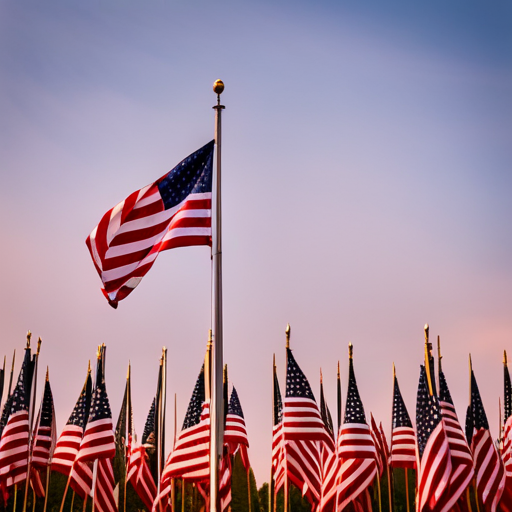
Have you ever wondered why the flag is at half mast today? It’s a question that may cross your mind as you go about your day, seeking safety and peace.
Well, the truth is, there could be various reasons for this solemn display. It could be a mark of respect and remembrance for fallen heroes, those who have sacrificed their lives for our safety.
It could also be a way to mourn the loss of prominent figures who have made a significant impact on our nation. Sometimes, it signifies a national tragedy, reminding us to come together and support one another in times of grief.
Understanding the significance behind the flag at half mast helps us appreciate the importance of honor, unity, and the need to cherish those who have made a difference.
Historical Significance
You may be wondering about the historical significance behind the flag being at half mast today. The flag at half mast is a solemn display that holds great meaning. It’s often done to honor and remember significant historical events and commemorative dates. By lowering the flag halfway down the flagpole, it symbolizes a nation or community in mourning.
Historical events such as the anniversary of a national tragedy, the passing of a prominent leader, or the commemoration of a significant event in history can prompt the flag to be flown at half mast. It serves as a visual reminder of the impact and importance of these events in our collective memory.
Communities and nations use this visible gesture to pay respect, remember, and reflect upon the sacrifices made and the lives lost during these historical events. It helps us show solidarity and unity as we honor the past and strive for a safer future.
National Tragedies
National tragedies prompt the flag to be flown at half mast, serving as a solemn reminder of the profound impact and loss experienced by the entire nation. These tragic events are deeply unsettling and can have far-reaching consequences. They shake the foundation of our communities and leave lasting scars on our collective consciousness. During such times, healing becomes a crucial part of the process, and community support plays a vital role in helping individuals and the nation as a whole to recover.
| National Tragedies | Healing Process | Community Support |
|---|---|---|
| Natural Disasters | Providing resources for recovery and reconstruction efforts | Donating supplies, volunteering, and offering temporary shelter to those affected |
| Acts of Terrorism | Offering counseling and mental health support to survivors and families of victims | Organizing fundraisers and memorial events to honor the lives lost |
| Mass Shootings | Providing immediate medical care and trauma counseling to survivors | Advocating for gun control and supporting initiatives to prevent future violence |
| Pandemics | Facilitating access to healthcare, vaccines, and mental health services | Promoting public health measures and supporting affected businesses and individuals |
National tragedies test our resilience and require us to come together as a nation. It is during these trying times that the flag at half mast reminds us of the strength and unity needed to overcome adversity. By actively participating in the healing process and providing community support, we can help rebuild shattered lives, restore hope, and ultimately move towards a brighter future.
Honoring Fallen Heroes
Today, as you look up at the flag at half mast, you may be wondering why we’re honoring fallen heroes. It’s important to remember that our military sacrifices their lives to protect our safety and freedom. Honoring fallen heroes is a way to show our gratitude and respect for their ultimate sacrifice.
Memorial ceremonies are held to pay tribute to these brave men and women who’ve given their lives in service to our country. These ceremonies provide an opportunity for us to come together as a community to remember and honor the fallen. They serve as a reminder of the sacrifices made by our military members and their families.
During memorial ceremonies, various rituals and traditions are observed. These may include the playing of Taps, a moment of silence, the laying of wreaths, and the folding and presentation of the American flag to the fallen hero’s family. These acts symbolize our appreciation and reverence for their service and sacrifice.
Mourning the Loss of Prominent Figures
As you glance at the flag at half mast, you may be aware that it symbolizes the mourning of significant individuals. This solemn gesture is often seen in the aftermath of the loss of prominent figures.
When news of their passing reaches the public, the reaction can vary widely. Many people feel a deep sense of sadness and may express their grief through social media or by attending memorial services. It isn’t uncommon for communities to come together to honor the memory of these individuals, organizing candlelight vigils or moments of silence.
The flag at half mast serves as a visual reminder of the impact these figures had on society and the void their absence leaves behind. This symbolic gesture allows the nation to collectively grieve and pay their respects. It acknowledges the importance of their contributions and reminds us of the lasting legacy they leave behind.
In a world that often feels uncertain, these public displays of mourning provide a sense of unity and comfort in the face of loss.
Symbol of Respect and Remembrance
To show respect and remember significant individuals, the flag is lowered to half mast. This gesture is a symbol of mourning and remembrance, and it holds deep meaning for many people. It’s a way to honor those who’ve made great sacrifices, such as fallen soldiers and prominent figures who’ve passed away. The flag at half mast serves as a visual reminder of our collective loss and a symbol of our gratitude.
One important occasion when the flag is lowered to half mast is on Veterans Day, a day dedicated to honoring and remembering the brave men and women who’ve served in the military. By lowering the flag, we pay tribute to their courage, sacrifice, and dedication to protecting our freedom.
The flag is also lowered during funeral processions as a mark of respect for the deceased. This solemn act acknowledges the loss of a loved one and honors their memory. It’s a way to show support for the grieving family and to express our condolences.
Protocol and Etiquette
When the flag is at half mast, it’s important to familiarize yourself with the protocol and etiquette associated with this solemn display of respect and remembrance. Following the proper etiquette guidelines ensures that you show the appropriate level of reverence and honor for the occasion.
Firstly, it’s essential to understand the symbolism of the flag at half mast. It’s lowered to honor the memory of individuals who’ve passed away, particularly those who’ve served in the military or held important positions. This gesture is a sign of mourning and solidarity with the bereaved.
When the flag is at half mast, it’s customary to observe a moment of silence and reflect upon the sacrifices made by those being honored. It’s important to maintain a respectful and solemn demeanor during this time.
Additionally, it’s crucial to remember that the flag should never touch the ground at any time. If you’re responsible for raising or lowering the flag, be careful to handle it with care and avoid any disrespectful mishaps.
Cultural Differences and International Practice
You should consider cultural differences and international practice when trying to understand the significance of the flag being at half mast. Cross-cultural understanding and knowledge of diplomatic customs are essential in interpreting the meaning behind this solemn gesture. Different countries and cultures have their own protocols and traditions for displaying the flag at half mast, and it is important to respect and acknowledge these differences.
To illustrate the variations in flag etiquette, let’s take a look at a comparison table:
| Country | Flag at Half Mast Significance |
|---|---|
| United States | National mourning, death of a prominent figure or tragedy |
| United Kingdom | Death of a member of the royal family or national tragedy |
| Japan | Mourning period for the emperor or other high-ranking figure |
| India | Death of the president, prime minister, or other dignitaries |
| Australia | Mourning period for a significant loss or tragedy |
| France | Death of a national figure or to commemorate a tragedy |
Understanding these cultural differences and international practices can help foster mutual respect and avoid misunderstandings. It also allows us to appreciate the diversity and richness of different cultures. By observing and learning from diplomatic customs around the world, we can strengthen our global connections and promote harmony and understanding.
Frequently Asked Questions
What Is the Specific Reason for the Flag Being at Half-Mast Today?
The specific reason for the flag being at half mast today is unknown without context. It could be due to a national tragedy, the death of a prominent figure, or a sign of mourning.
How Long Will the Flag Remain at Half-Mast?
The flag will remain at half-mast until further notice. This is in accordance with protocol for honoring a significant event or loss. The duration depends on the specific circumstances and is determined by authorities.
Are There Any Exceptions or Special Circumstances When the Flag Is Not Lowered to Half-Mast?
Exceptions or special circumstances may arise when the flag is not lowered to half-mast. It’s important to understand these exceptions to ensure flag protocol is followed correctly. Safety and respect should always be prioritized.
What Is the Procedure for Raising and Lowering the Flag to Half-Mast?
To properly raise or lower the flag to half-mast, follow flag protocol and flag etiquette. Begin by hoisting it to the top, then lower it halfway down the flagpole. Always ensure safety while handling the flag.
Are There Any Symbolic Gestures or Customs Associated With the Flag Being at Half-Mast?
When the flag is at half mast, it holds a symbolic meaning of respect and mourning. This tradition has historical significance, reminding us of the sacrifices made and honoring those who have passed.
Conclusion
In conclusion, understanding why the flag is at half mast today is crucial for showing respect and remembrance.
Whether it’s to honor fallen heroes, mourn national tragedies, or pay tribute to prominent figures, the flag serves as a powerful symbol.
It’s important to follow the protocol and etiquette associated with flying the flag at half mast, while also recognizing that cultural differences and international practices may vary.
By doing so, we honor the past and signify our collective grief and unity.



Thank you for your sharing. I am worried that I lack creative ideas. It is your article that makes me full of hope. Thank you. But, I have a question, can you help me?